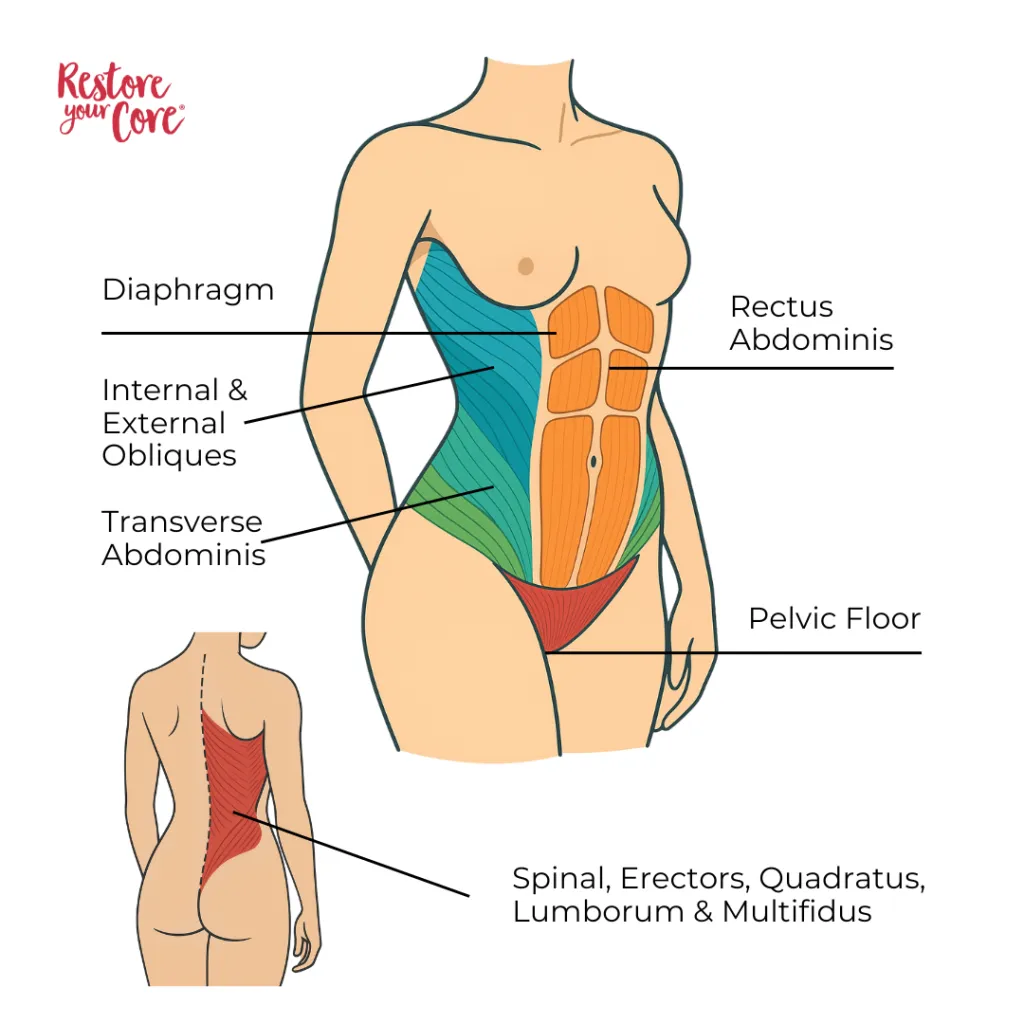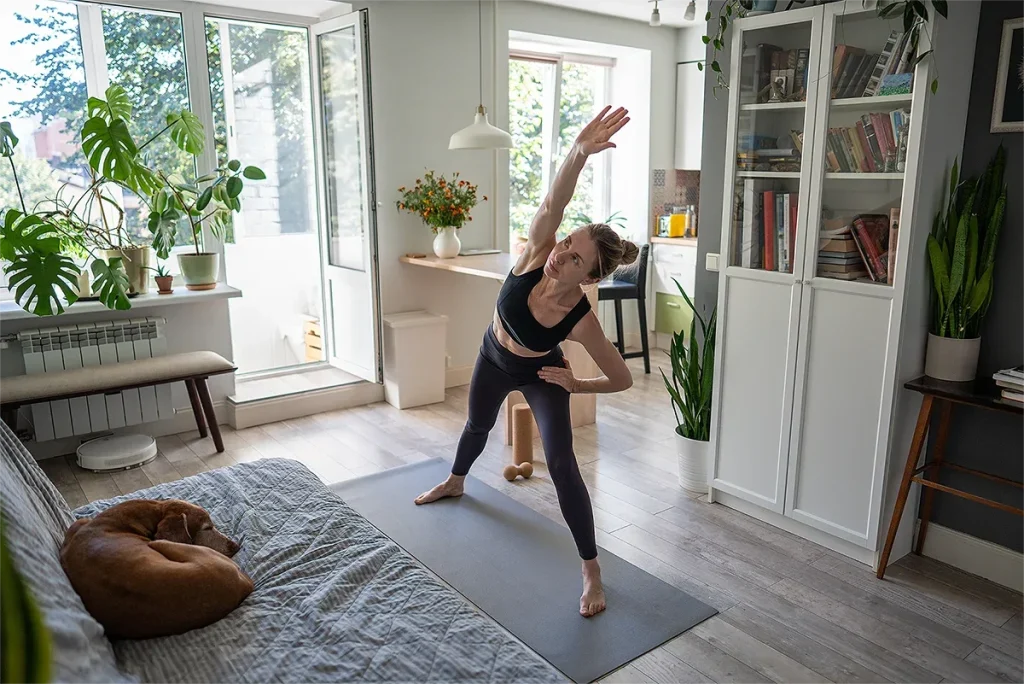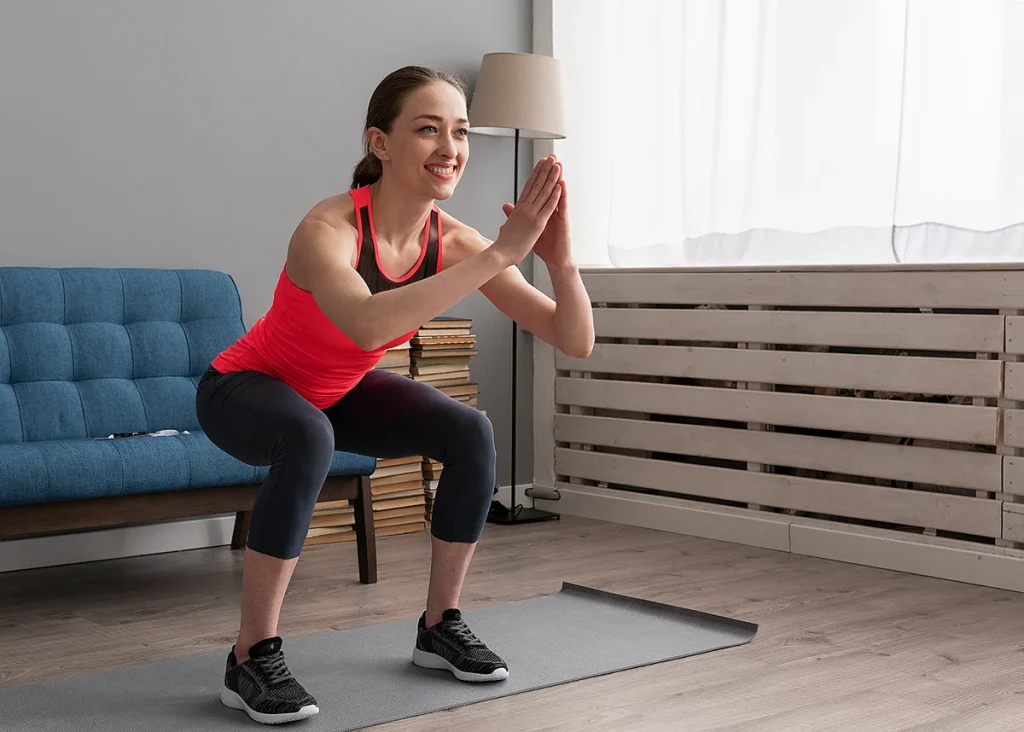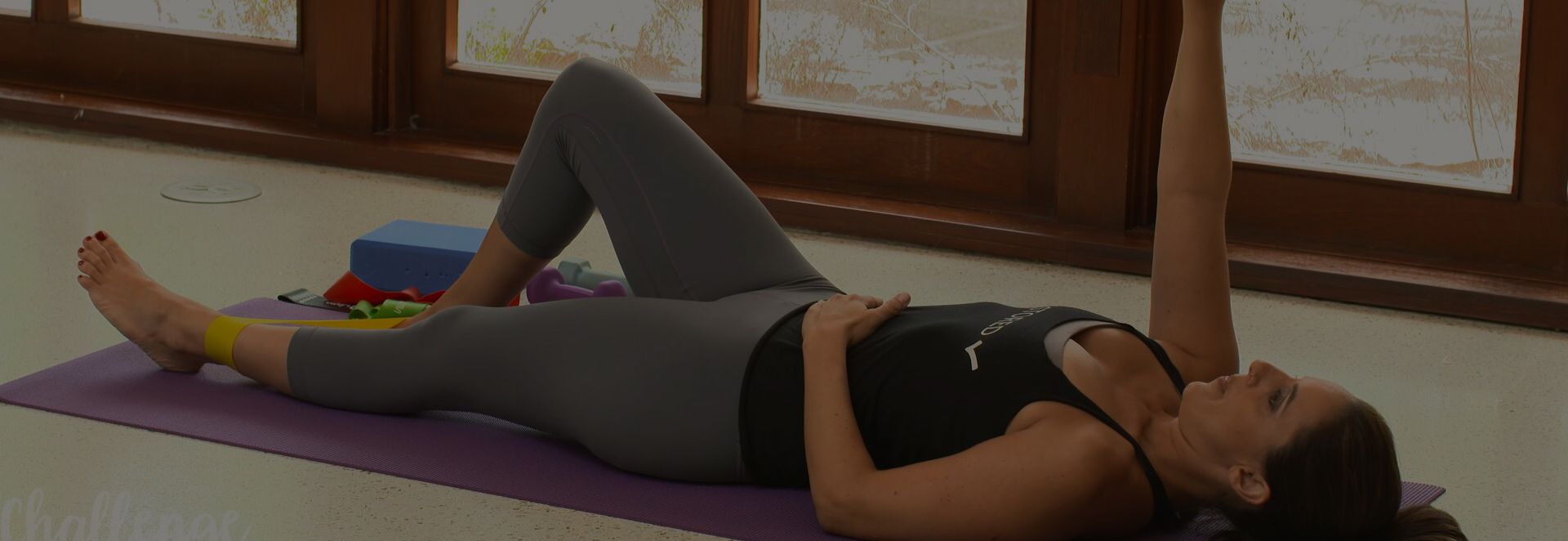Resources
Strengthen your core safely: 6 easy standing core exercises for beginners
By Vidya Acharya 05/26/2025
4 Min Read
Are you looking to build core strength but struggle with traditional core exercises done on the floor? Standing core exercises offer an accessible alternative to anyone new, returning to fitness, or short on time. In this article, you will learn what your core really is, discover how to properly engage these muscles, and master six practical standing core exercises. These moves are designed to fit into your busy life and help you feel stronger, more stable, and in control of your fitness journey.
Table of Contents
What do Beginners Generally Struggle with?
As a beginner working on abdominal strength, you may find it challenging to activate these muscles for several reasons:
- You might not know how to engage your core muscles properly
- You may struggle to feel these muscles (less awareness)
- Traditional exercises such as sit-ups and curl-ups may be challenging and could increase the risk of a neck or back strain
- If your core isn’t working as it should, other muscles tend to take over, which can reduce the effectiveness of your workout
Why are Standing Core Workouts Ideal for Beginners?
Standing core exercises are a good option for beginners looking for exercises to train the core. These are safe and effective, enabling you to build strength and improve overall fitness. As the name suggests, you perform these exercises standing, mimicking everyday activities, such as squatting, reaching, and bending down, making them more relevant.
A standing approach to core training enhances functional fitness by incorporating natural movements that reflect daily life. This approach strengthens the midsection and protects against injuries [1]. Exercising in an upright position improves trunk stability and engages postural muscles in an integrated manner, enhancing balance and coordination [2]. Because these exercises are performed upright, they build strength and control in ways that directly apply to real-world demands. As a result, your core becomes more responsive and resilient, better equipping you for daily activities.
Benefits of Standing Core Exercises with No Equipment
- Easily incorporated into your busy life. You can do these exercises without getting on the floor, at home or work
- Standing core exercises utilize your bodyweight for resistance, allowing you to build strength without weights or additional equipment
- They strengthen your entire body — from the centre of the body to the extremities — while improving posture, balance, and increasing body awareness
- Plus, they support your daily activities and help you move freely and perform better in your daily life
Who can do Standing Core Exercises?
They are perfect for beginners just starting their fitness journey. They can also benefit diverse groups — including those with back pain, recovering from injuries, pregnant women who find it difficult to do floor exercises, older adults with limited mobility, individuals facing balance issues, and people with busy lifestyles looking for quick, effective workouts.
Understanding your Core
Strong functional central support muscles are essential for almost all physical activities, from everyday movements to athletic performance. But what exactly is the “core”?
It refers to the muscles of the trunk — the central part of your body, often called the torso — that provide stability to the spine and transfer forces from the trunk to your arms and legs. Let’s look at the anatomy of the core to understand it better.
Anatomy of the core
Knowing the structures helps you understand what you are working on, allowing you to train your abdominal muscles effectively. Think of your core as a three-dimensional container that consists of:
- Front: Your abdominal muscles, the visible “six-pack’ (rectus abdominis)
- Back: Paraspinal muscles that support your spine and maintain posture
- Top: Your diaphragm, the primary breathing muscle
- Bottom: Your pelvic floor and hip muscles are at the bottom

The Core Anatomy
Functional Classification
Let’s break this anatomy further. The trunk muscles fall into two functional categories that work together as a team to bring stability and facilitate optimal movement: [3]
- Local muscles: These muscles help to stabilize your spine before the movement begins. They include the transverse abdominis, diaphragm, internal oblique, multifidus, pelvic floor, and lower back muscles.
- Global muscles: also known as movers. They provide stability and mobility, generating power and facilitating large movements [4]. They are the rectus abdominis, psoas, gluteus, back extensors, and external obliques.
How Your Core Functions
What makes your torso musculature unique is its pre-anticipatory nature, meaning it ‘switches on’ or activates before any movement is attempted. This automatic engagement creates stability before mobility, protecting your spine and optimizing movement efficiency.
Your core responds to both movement and external load. They function continuously, working in conjunction with your breath and are influenced by your body alignment.
Training Implications
Because your core functions as an integrated system rather than isolated muscles, comprehensive training requires more than just traditional crunches or sit-ups.
To optimally engage the core, it is necessary to incorporate dynamic whole-body movements that specifically target all these muscles.
How to Find Your Core Muscles
Exercising your core involves much more than just pulling in your belly or “sucking your belly button to your spine.”. Proper core engagement includes coordinated activation of the transverse abdominis, diaphragm, pelvic floor, and spinal stabilizers to support movement and maintain stability. For beginners, activating these muscles can be challenging due to factors like limited body awareness, improper breathing techniques, restricted mobility in the ribs, spine or hips, and habitual movement patterns. Recognizing and addressing these barriers is key to achieving efficient core function.
Core Engagement Assessment
Here is a quick way to feel the core engagement in the standing position:
- Place your hands on your belly
- Take a deep breath in
- As you exhale, slowly start saying the letters a, b, c, and so on
- Notice what happens to your belly.
As you speak each letter, you should ideally feel your belly drawing in and moving away from the hand–this indicates that your core muscles are responding appropriately. Intrinsic trunk muscles work together to modulate the intra-abdominal pressure and adapt to the changes during everyday functions, like breathing, speaking, singing, urination, defecation, and strenuous physical activity [5]. You can observe how well your core responds by noticing what happens when you laugh, talk or cough. Ideally, your abdomen should draw inward, creating a firmer abdominal wall that provides postural support.
Avoid Ineffective Core Strategies
It is important to recognize and avoid ineffective core strategies, such as:
- Bulging is when your belly pushes out instead of drawing in
- Bracing is tensing the front abdominal wall as if you are about to be hit
- Bearing down refers to the downward pressure that happens during a bowel movement
These strategies do not adequately provide the support your body needs and can increase your risk of injury. By being aware of and avoiding these ineffective strategies, you can improve core function and stability and move with greater confidence and control.
Restore Your Core® is a 12-week online program offering a comprehensive, step-by-step approach to improve core strength. The program incorporates essential techniques for proper breathing, alignment, and progressive movement strategies to restore core function and whole-body integration.
Also, you can learn more about Dos and Don’ts of Core Engagement by watching this video:
6 Beginner-Friendly Standing Core Exercises
Preparing Your Body: Alignment Check
Before you begin, it is good to do an alignment check while standing. Proper alignment ensures optimal core activation. Start by positioning your feet hip-width apart and pointing your toes forward. Ensure your hip, knee, and ankle joints are stacked directly above one another. Maintain a neutral pelvis, not tilted forward or backwards, and align your ribcage directly above it. Finally, keep your neck long, not allowing the chin to jut forward. This posture allows your muscles to activate properly and work more efficiently throughout the workout.
Here are 6 standing core exercises from the RYC program:
1. Engage your core in standing
An appropriate breathing pattern promotes optimal core engagement. Activating the deep stabilizers before movement is essential to support the body while moving. This exercise helps you efficiently engage the core before you begin to move.
- Stand with proper alignment
- Place your hands on the belly
- Take a deep breath in
- Breathe out slowly through pursed lips. Exhale slowly and steadily as if blowing out 100 candles on a birthday cake
- Feel the core engaging. You should feel your abdominal wall move upward and inward
- Repeat this exercise 3 to 5 times
- Practice this exercise a couple of times each day
2. Side bend
This exercise targets the obliques and muscles of the upper body. Incorporating side bends into your training can improve spinal flexibility and balance.
- Stand with feet hip-width apart
- Inhale while lifting your right arm out to the side and overhead
- Ensure you are not thrusting your ribs or shrugging your shoulder towards your ear
- As you exhale, blow candles, feeling your core engage and side bend to the left
- Keep your hips stable and ensure they are not shifting sideways
- Notice if your core is pushing out
- Remember to breathe– do not hold your breath
- Inhale to return to the centre, exhale to lower your arm
- Repeat it on the left side.
- Repeat 5 to 8 times on each side

3. Hip hinge
Hip hinge targets the core, as well as the muscles in the back of your hips and thighs, like your glutes and hamstrings. This basic movement pattern is used to perform tasks like bending over and lifting objects from the ground. It improves flexibility, functional strength and mobility.
- Stand with your feet placed hip-width apart
- Start by placing your hands on your waist, then slide your hands forward to locate the bony prominences at the front of your pelvis, known as the ASIS (Anterior Superior Iliac Spine)
- Inhale deeply
- As you exhale, blow out the candles, engage your core and tip your trunk forward so the bony prominences point to the floor
- Make sure you are not rounding or arching your lower back and pelvis
- Imagine pushing into your heels as if preparing to stand, but stay in this position. It helps to build strength and further engages your deep core stabilizers
- Inhale to stand up, pointing the bony prominence towards the wall in front of you
- Repeat 5 to 8 times
4. Squat
This is an excellent exercise for training the core in standing. It also strengthens the hips, knees, ankles and feet.
- Stand with your toes pointing in front and your feet hip-width apart
- Inhale deeply
- Exhale, blowing out candles and bend your knees to squat
- Ensure that the shins are vertical as if you were about to sit back into a chair
- Notice if your pelvis is tucked under or if you are over-arching your spine and thrusting your ribs forward
- Use the mirror to check your alignment
- As you squat, ensure the weight is in your heels. Stay here for three counts
- Inhale, exhale to engage your core, and press through your heels to come to the standing position
- Repeat 5-8 times

5. Cat-cow in standing
This exercise is often performed on all fours, but can also be done while standing. It helps improve mobility in the spine, ribcage, and pelvis while encouraging awareness of your breath and core activation.
- Stand with knees slightly bent, similar to a mini-squat
- Take a deep breath in
- As you exhale, feel your core engage. Start by tucking your pelvis under and rounding your entire spine like a cat
- Inhale, untuck your pelvis, arch the spine segmentally, and open your ribcage like a cow
- Continue alternating between cat and cow positions with each breath: exhale into cat and inhale into cow
- Repeat this sequence 5 to 8 times
6. Wall Push-up
The wall push-up is a modified plank, which engages trunk muscles and strengthens the upper body. It is an excellent standing core exercise that utilizes bodyweight to strengthen the postural muscles, arms and shoulders.
- Stand facing a wall. Place your hands on the wall. Make sure your shoulders are above your hands, with your elbows slightly bent and pointing down
- Walk your feet a comfortable distance away from the wall and ensure the spine is neutral
- Inhale
- As you exhale, push the wall away from you, as if you were moving a heavy piece of furniture, feel your core respond
- Repeat this 5 times
Start Building Your Core Strength
Start practicing these core exercises today! They are simple, require no equipment and can be performed anytime and anywhere, empowering you to take control of your fitness. You can integrate these movements smoothly into daily activities. For instance, notice how your core responds while reaching for an overhead shelf, drying your hair, or squatting to empty the dishwasher.
Remember, it is not about doing many repetitions; it’s about engaging and activating these muscles in a controlled way. Even doing it for just 5 minutes a day can make a difference. All it needs is a conscious effort!
Initially, you may struggle to perceive core engagement, and that’s okay. But with consistent practice and focus on your alignment and breath, you will see a noticeable improvement with time. Consistency is the key, and progress slowly!
By incorporating these exercises into your routine, you will not only strengthen your core but also improve your balance, posture, and the way you move in everyday life.
Once you have established a strengthening routine and successfully mastered your core engagement strategy, it is important to progress gradually, introducing safe loads to promote strengthening and support long-term healing. If you are looking for a structured and supportive approach to core strength, the Restore Your Core® online program offers a comprehensive 12-week path to deep core strength. Through step-by-step instruction, you’ll learn essential techniques like optimal breathing, alignment, and progressive movement strategies to improve core function and support whole-body integration.
Final Thoughts on Standing Core Exercises for Beginners
These easy standing core exercises are an ideal starting point for beginners. They’re low-risk, easy to follow, and help you build core strength without needing any equipment, so you can do them anytime, anywhere. As you continue your fitness journey, starting with safe, accessible movements like these — and practicing them consistently — can lay the foundation for long-term strength, stability, and confidence in your body.
FAQ
1. How do I know if I’m engaging my core properly?
When your core engages, you should feel these muscles moving in and up on an exhale. Our core should engage reflexively with the breath and load. Pay attention to your breathing technique and standing alignment for optimal activation. Make sure that you are not bulging or bracing while performing the exercises.
To understand the core strategy, have a look at this video.
2. How can I prevent losing balance during standing core exercises?
You can initially use a table, chair, or wall for support until your coordination improves and you feel more confident.. Also, stand with your feet hip-width apart to have a stable base.
3. How long should a beginner’s standing core workout last?
A standing workout of about 10 to 15 minutes is good. Focus on the quality of the movement rather than the duration. Consider practising daily and aim for at least five times per week.
4. Do I need to modify standing core exercises if I have a weak lower back?
If you have a weak lower back, you can modify your exercises so they do not strain your lower back. Limit your range of motion initially. Try smaller ranges and slow, controlled movements to ensure correct abdominal engagement. Focusing on alignment, breathing, and core activation when performing the exercises will help support your back.
5. How do I track progress when starting a standing core training plan?
There are several ways you can check your progress. Start by tracking the baseline measurements, such as the number of exercises you can accomplish, before experiencing core muscle fatigue. Keep a diary to log daily routines, including the reps for each exercise. As you develop strength, increase the number of repetitions or add an extra set. Pay attention to how your body feels during and after the workouts. Improvements in your abdominal muscle response and strategy, overall stability, balance, and posture can be good indicators of progress. Also, taking photos or videos to check your form and movement while exercising can help you notice subtle improvements in form.
6. What should I do if I don’t feel sore after a standing core workout? Am I doing it wrong?
Not necessarily! Soreness isn’t the only — or even the best — indicator of an effective workout. In fact, not feeling sore can simply mean your body is adapting well to the movements. That said, if you’re not noticing improvements in control, strength, or coordination, you may not be engaging your core muscles as effectively as possible.
Ensure you’re using proper technique, paying attention to alignment, and coordinating your breath with each movement. If you’re unsure, reviewing foundational strategies — like those taught in the Restore Your Core® program—can help you develop a more responsive core and work through common challenges.
If you’ve been doing the same exercises regularly, your muscles may need more challenge. To increase the intensity, try adding a pause at the end range of motion, using handheld weights, or increasing the number of reps.
References
[1] Akuthota, V., & Nadler, S. F. (2004). Core strengthening. Archives of physical medicine and rehabilitation, 85, 86-92.https://pubmed.ncbi.nlm.nih.gov/15034861/
[2] Akuthota, V., Ferreiro, A., Moore, T., & Fredericson, M. (2008). Core stability exercise principles. Current sports medicine reports, 7(1), 39-44.https://journals.lww.com/acsm-csmr/Fulltext/2008/01000/Core_Stability_Exercise_Principles.14.aspx
[3] Teixeira, C. V. L. S., Evangelista, A. L., Silva, M. S., Bocalini, D. S., Da Silva-Grigoletto, M. E., & Behm, D. G. (2019). Ten important facts about core training. ACSM’s health & fitness journal, 23(1), 16-21.https://www.researchgate.net/publication/329100874_Ten_Important_Facts_About_Core_Training
[4] Lee K. The relationship of trunk muscle activation and core stability: a biomechanical analysis of pilates-based stabilization exercise. International journal of environmental research and public health. 2021 Dec 4;18(23):12804.https://pmc.ncbi.nlm.nih.gov/articles/PMC8657451/
[5] Talasz, H., Kremser, C., Talasz, H. J., Kofler, M., & Rudisch, A. (2022, June). Breathing,(S) training and the pelvic floor—a basic concept. In Healthcare (Vol. 10, No. 6, p. 1035). MDPI.https://pubmed.ncbi.nlm.nih.gov/35742086/



